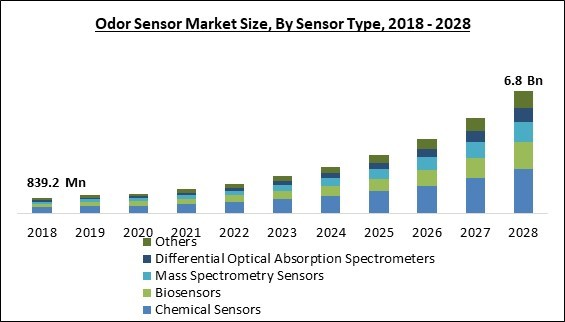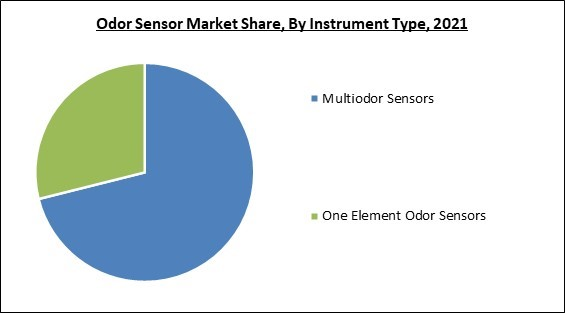The Global Odor Sensor Market size is expected to reach $6.8 billion by 2028, rising at a market growth of 26.7% CAGR during the forecast period.
The term 'odor sensor'refers to a device that measures and identifies certain volatile organic compounds, or VOCs, in the air (VOCs). These sensors may be utilized in various applications, including the control of industrial processes, the grading of food and beverages, and the monitoring of air quality. There are various kinds of odor sensors, including metal oxide semiconductor (MOS) sensors, whichdetect volatile organic compounds (VOCs) using a metal oxide sheet, such as tin oxide.
They are sensitive to various VOCs and can detect them, but they are also subject to variations in humidity and temperature. Electrochemical sensors identify VOCs by a chemical reaction. While they can detect fewer VOCs than MOS sensors, they are more selective. These sensors detect VOCs by using live organisms like bacteria or yeast. They need careful handling and upkeep while being very selective and capable of detecting a variety of VOCs.
Photoionization Detector (PID)sensors ionize VOCs using UV light, which an electronic circuit subsequently detects. While they are very sensitive and capable of detecting a variety of VOCs, they are also sensitive to changes in temperature and humidity. Infrared (IR) sensorsmeasure how much-infrared light is absorbed or reflected by the VOCs to determine their presence. While they are picky, humidity and temperature variations can impact them. Surface Acoustic Waves (SAW) sensorsmeasure the variations in the mechanical waves brought on by the VOCs to identify their presence. They are susceptible and selective but susceptible to variations in temperature and humidity.
The market research report covers the analysis of key stake holders of the market. Key companies profiled in the report include Panasonic Holdings Corporation, Honeywell International, Inc., Dragerwerk AG & Co. KGaA, Envirosuite Ltd., Figaro Engineering, Inc. (New Cosmos Electric Co., Ltd.), Aryballe Technologies, Membrapor AG, Alphasense, Inc., Aeroqual Ltd., and Comon Invent B.V.
The term 'odor sensor'refers to a device that measures and identifies certain volatile organic compounds, or VOCs, in the air (VOCs). These sensors may be utilized in various applications, including the control of industrial processes, the grading of food and beverages, and the monitoring of air quality. There are various kinds of odor sensors, including metal oxide semiconductor (MOS) sensors, whichdetect volatile organic compounds (VOCs) using a metal oxide sheet, such as tin oxide.
They are sensitive to various VOCs and can detect them, but they are also subject to variations in humidity and temperature. Electrochemical sensors identify VOCs by a chemical reaction. While they can detect fewer VOCs than MOS sensors, they are more selective. These sensors detect VOCs by using live organisms like bacteria or yeast. They need careful handling and upkeep while being very selective and capable of detecting a variety of VOCs.
Photoionization Detector (PID)sensors ionize VOCs using UV light, which an electronic circuit subsequently detects. While they are very sensitive and capable of detecting a variety of VOCs, they are also sensitive to changes in temperature and humidity. Infrared (IR) sensorsmeasure how much-infrared light is absorbed or reflected by the VOCs to determine their presence. While they are picky, humidity and temperature variations can impact them. Surface Acoustic Waves (SAW) sensorsmeasure the variations in the mechanical waves brought on by the VOCs to identify their presence. They are susceptible and selective but susceptible to variations in temperature and humidity.
COVID-19 Impact Analysis
The usage of biosensors in COVID-19 also increased due to theirbenefits of effective diagnosis of COVID-19. Biosensors are the most precise, fast, user-friendly, sensitive, and capable of delivering point-of-care diagnostics above and beyond conventional norms. This market had the opportunity to enter the diagnostic technology industry during the COVID-19period. Research and development are being done on how to use digital technology to detect COVID-19. The e-nose is one of the most important digital smell technology gadgets. The technological advancements in the odor sensor market, combined with its usage in diagnosing COVID-19, will aid in the market growth.Market Growth Factors
Increase in knowledge of air pollution and its detrimental consequences on health
Many elements, including living close to industrial air pollution sources, underlying health issues, inadequate nutrition, stress, and others, may exacerbate the effects on these populations’ quality of life. The elements that may determine whether a population or age group is more likely to experience the negative impacts of air pollution on their health need to be better understood. The rising air pollution due to the high globalization and industrialization, joined with the rising awareness amongst the people and the government to counter this, will surge the usage of odor sensors to better study the adverse effects of air pollution and thereby boost the market growth.Increasing demand for building and home automation
The industry for smart homes has grown due to an increasing acceptance rate of IoTs in both established and emerging nations. The ability of technology to enable device interconnection has contributed to increasing demand for the industry. Leading companies have developed total, state-of-the-art home automation products that may help the user detect smoke and gas leaks, pressure levels, switches, actuators, remotely programmable switchboards, and more with sensors. The rising preference for smart homes is expected to increase the usage of odor sensors in these homes for various purposes, which are anticipated to propel market growth.Market Restraining Factor
High initial cost of odor sensors
The employment of injection techniques has an impact on the device's initial cost, and the machines' several sensors increase the amount spent on it. As a result, producers are required to put greater effort into creating a piece of compact, economical equipment. And high investments in creating more sophisticated odor sensors and electronic nose is required by the manufacturers to making these products. The high cost of production due to the integrated artificial intelligence and neuromorphic technologies joined with the needed significant investment in the industry to provide better final products are expected to hinder the odor sensors market growth in the projected period.Application Outlook
Based on application, the odor sensor market is segmented into smell visualization & standardization, food quality control, medical diagnosis, air control & environmental monitoring and others. The air control & environmental monitoring segment acquired a significant revenue share in the odor sensor market in 2021. This is because these devices demonstrated the capacity to identify and distinguish between a multitude of different gases and aromas with just a limited number of sensors, electronic nose applications in environmental monitoring are now of significant interest.End-use Outlook
On the basis of end use, the odor sensor market is divided into military & defense, agriculture, healthcare, HoReCa, entertainment, renewal energy generation & waste management, food & beverages, cosmetics and others. The agriculture segment procured a promising growth rate in the odor sensor market in 2021. This is due to the usage of different instruments for a variety of applications in the wide domains of agriculture and forestry. These instruments are descended from several kinds of aroma-sensor technologies. Recent developments in plant sciences-related e-nose technologies, including enhanced gas and odor-sensor architectures, novel data analysis and pattern-recognition algorithms, and advancements in material science and systems integration techniques, have had a substantial positive impact on both sectors.Sensor Type Outlook
By sensor type, the odor sensor market is classified into biosensors, chemical sensors, mass spectrometry sensors, differential optical absorption spectrometers and others. The chemical sensors segment witnessed the largest revenue share in the odor sensor market in 2021. This is because studying volatile organic molecules has often employed chemical sensors. Chemical sensor arrays with pattern recognition provide excellent selectivity and reversibility, opening up various application possibilities. The phrase 'electronic noses'describes such devices when they are utilized for scent analysis.Instrument Type Outlook
Based on the instrument type, the odor sensor market is bifurcated into one element odor sensors and multiodor sensors. The multiodor sensors segment generated the highest revenue share in the odor sensor market in 2021. This is because the multi-odor sensors system recognized numerous scents with great accuracy, sensitivity, and specificity. Learning to discriminate between distinct scents is crucial for a person to react swiftly and precisely to environmental changes, as different odors might be connected with various reactions. Also, multi-odor sensors utilize rats' intrinsic sense of smell and associative learning.Regional Outlook
Region-wise, the odor sensor market is analyzed across North America, Europe, Asia Pacific, and LAMEA. The Asia Pacific region led the odor sensor market by generating the maximum revenue share in 2021. The growth is attributed to fast industrialization and rising demand for energy and electricity. Additionally, the area is seeing a huge need for odor control systems due to a rise in the discharge of harmful pollutants and exhaust gases. Additionally, strict government laws for the emission of harmful air pollutants in various nations further drive market growth in the region.The market research report covers the analysis of key stake holders of the market. Key companies profiled in the report include Panasonic Holdings Corporation, Honeywell International, Inc., Dragerwerk AG & Co. KGaA, Envirosuite Ltd., Figaro Engineering, Inc. (New Cosmos Electric Co., Ltd.), Aryballe Technologies, Membrapor AG, Alphasense, Inc., Aeroqual Ltd., and Comon Invent B.V.
Scope of the Study
By Sensor Type
- Chemical Sensors
- Biosensors
- Mass Spectrometry Sensors
- Differential Optical Absorption Spectrometers
- Others
By Application
- Medical Diagnosis
- Air Control & Environmental Monitoring
- Food Quality Control
- Smell Visualization & Standardization
- Others
By Instrument Type
- Multiodor Sensors
- One Element Odor Sensors
By End-user
- Healthcare
- Renewal Energy Generation & Waste Management
- Food & Beverages
- Military & Defense
- Agriculture
- HoReCa
- Entertainment
- Cosmetics
- Others
By Geography
- North America
- US
- Canada
- Mexico
- Rest of North America
- Europe
- Germany
- UK
- France
- Russia
- Spain
- Italy
- Rest of Europe
- Asia Pacific
- China
- Japan
- India
- South Korea
- Singapore
- Malaysia
- Rest of Asia Pacific
- LAMEA
- Brazil
- Argentina
- UAE
- Saudi Arabia
- South Africa
- Nigeria
- Rest of LAMEA
Key Market Players
List of Companies Profiled in the Report:
- Panasonic Holdings Corporation
- Honeywell International, Inc.
- Dragerwerk AG & Co. KGaA
- Envirosuite Ltd.
- Figaro Engineering, Inc. (New Cosmos Electric Co., Ltd.)
- Aryballe Technologies
- Membrapor AG
- Alphasense, Inc.
- Aeroqual Ltd.
- Comon Invent B.V.
Unique Offerings
- Exhaustive coverage
- The highest number of market tables and figures
- Subscription-based model available
- Guaranteed best price
- Assured post sales research support with 10% customization free
Table of Contents
Chapter 1. Market Scope & Methodology
Chapter 2. Market Overview
Chapter 3. Global Odor Sensor Market by Sensor Type
Chapter 4. Global Odor Sensor Market by Application
Chapter 5. Global Odor Sensor Market by Instrument Type
Chapter 6. Global Odor Sensor Market by End-use
Chapter 7. Global Odor Sensor Market by Region
Chapter 8. Company Profiles
Companies Mentioned
- Panasonic Holdings Corporation
- Honeywell International, Inc.
- Dragerwerk AG & Co. KGaA
- Envirosuite Ltd.
- Figaro Engineering, Inc. (New Cosmos Electric Co., Ltd.)
- Aryballe Technologies
- Membrapor AG
- Alphasense, Inc.
- Aeroqual Ltd.
- Comon Invent B.V.
Methodology

LOADING...










